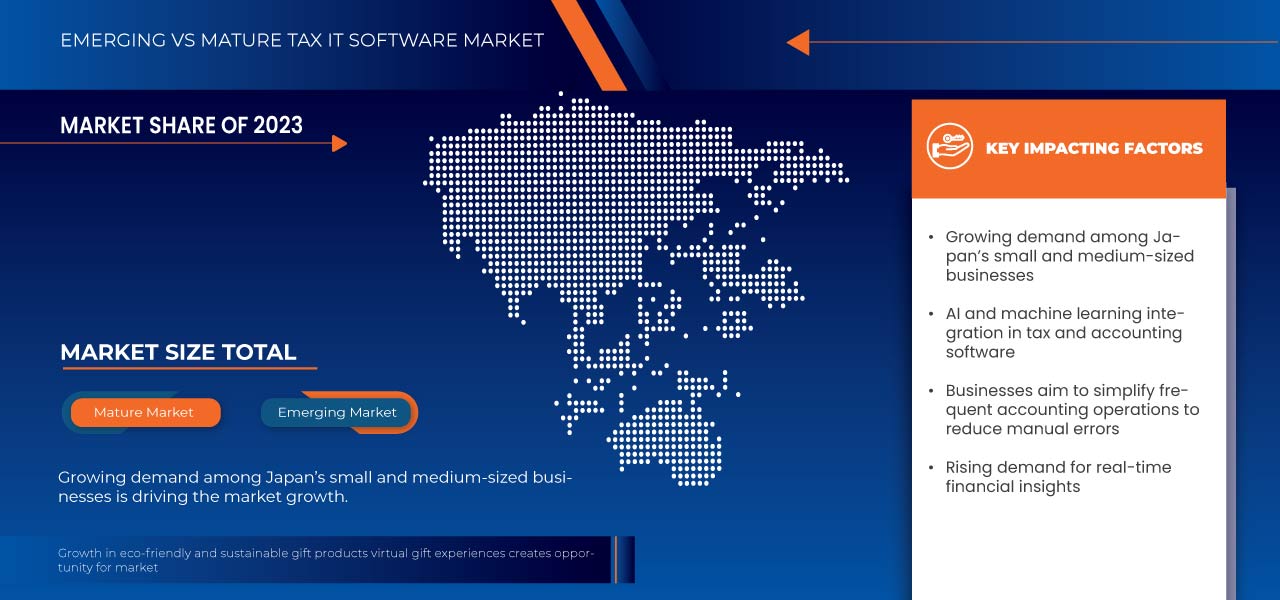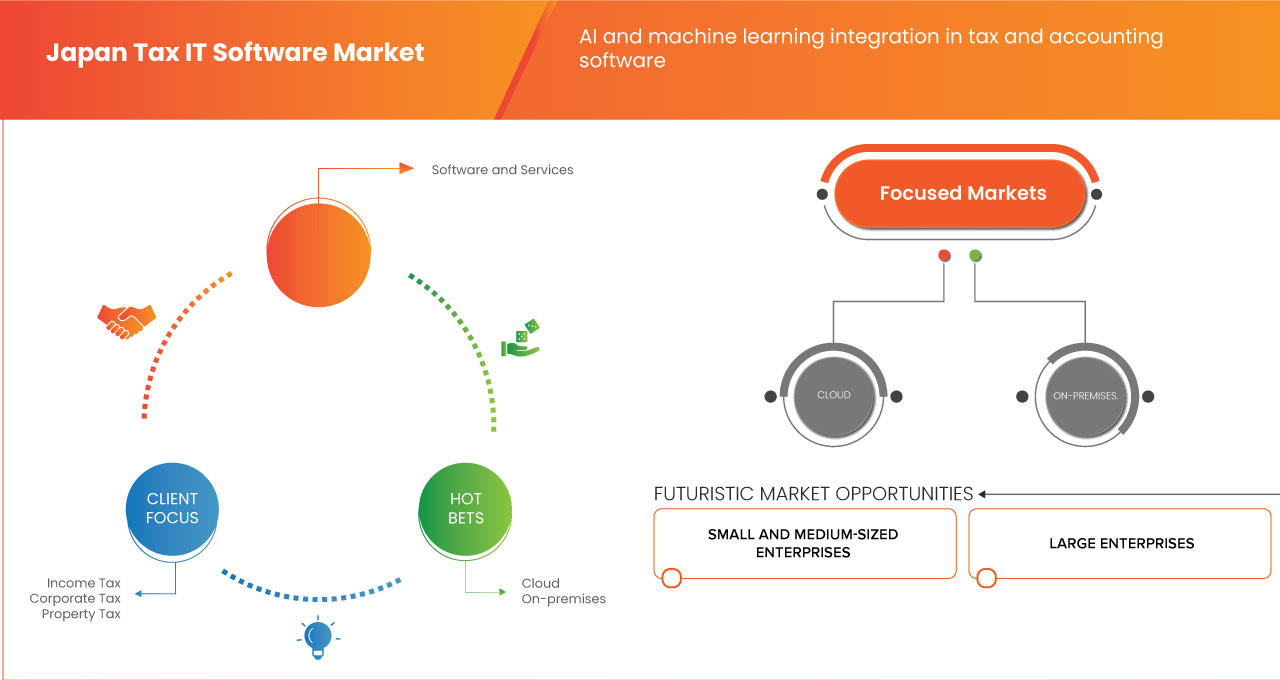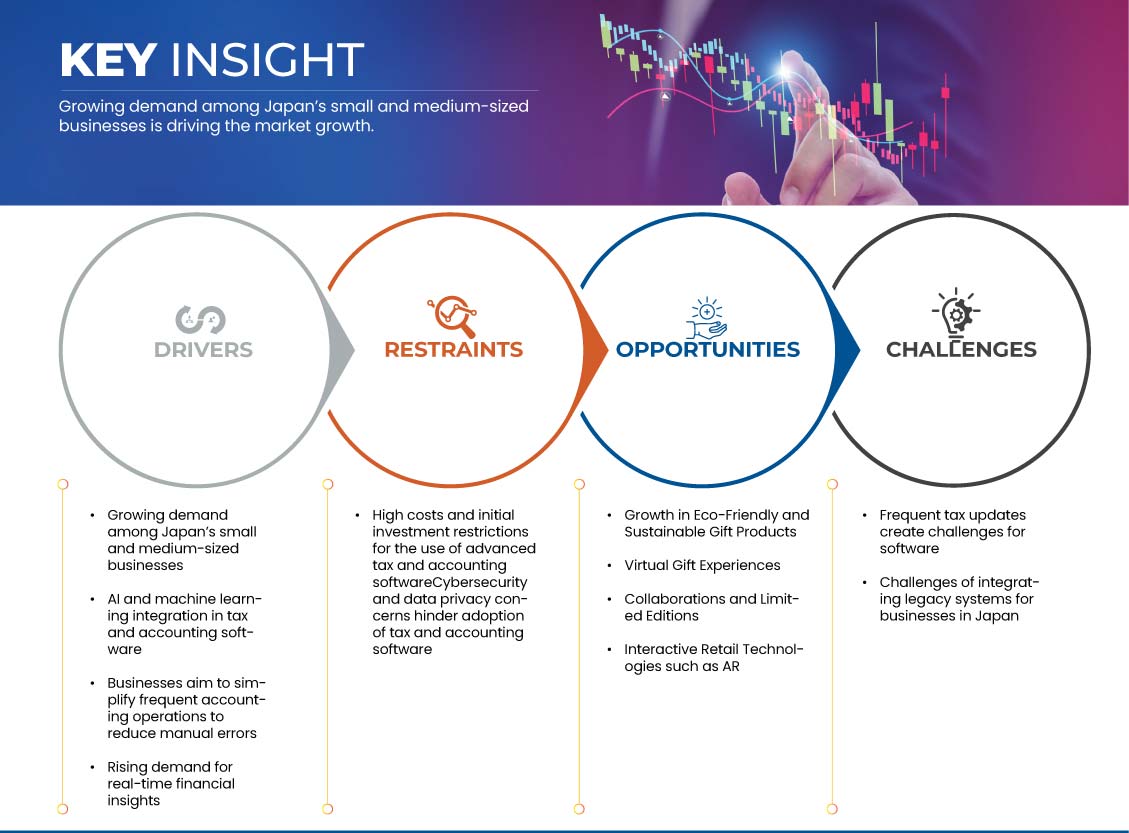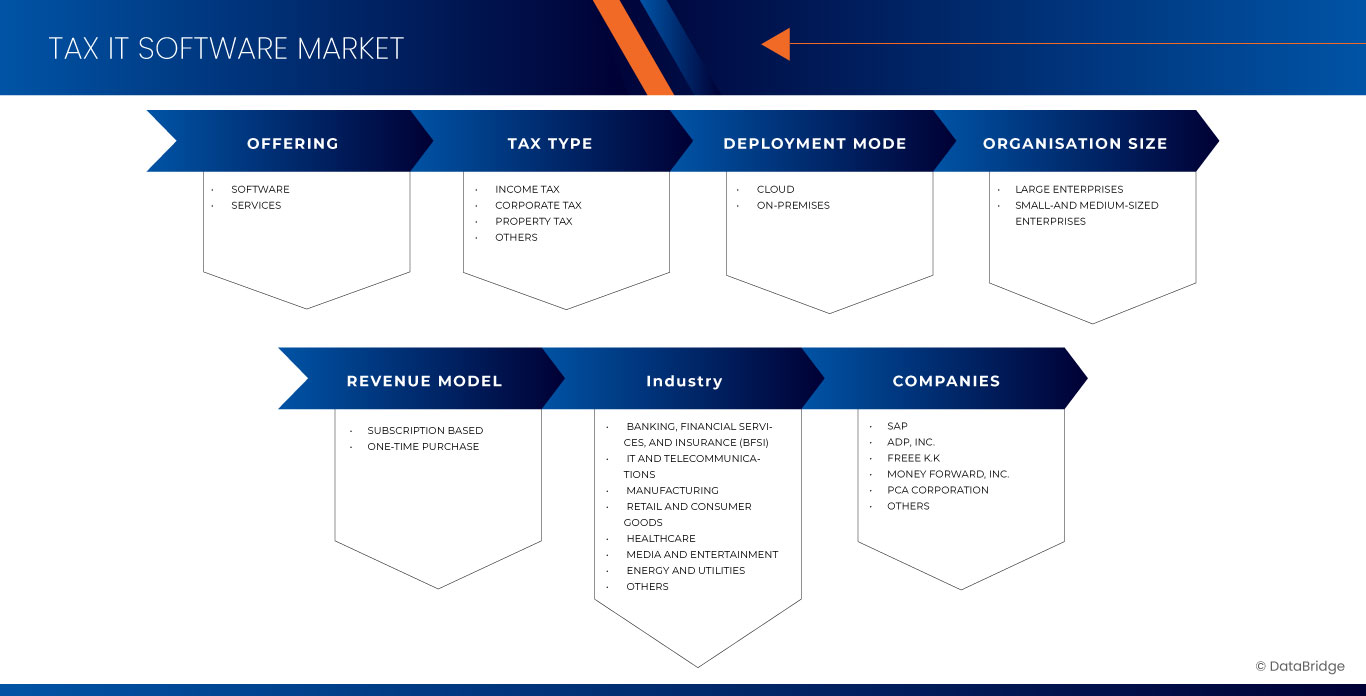Japan Tax It Software Market
حجم السوق بالمليار دولار أمريكي
CAGR :
% 
| 2025 –2032 | |
| USD 2.58 Billion | |
| USD 4.66 Billion | |
|
|
|
Japan Tax IT Software Market Segmentation, By Offering (Software and Services), Tax Type (Income Tax, Corporate Tax, Property Tax, and Others), Deployment Mode (New Cloud and On-Premises), Organization Size (Small And Medium-Sized Enterprises and Large Enterprises), Revenue Model (One-Time Purchase and Subscription Based) Industry (Banking, Financial Services, And Insurance (BFSI), IT And Telecommunications, Manufacturing, Retail And Consumer Goods, Healthcare, Energy And Utilities, Media and Entertainment, and Others) - Industry Trends and Forecast to 2032
Japan Tax IT Software Market Analysis and Size
The Japan IT tax software market is experiencing growth driven by increasing demand for compliance with evolving tax regulations and government digitization initiatives like e-Tax. Businesses are adopting automated solutions to reduce errors and enhance operational efficiency in tax filing. Integration of AI and real-time analytics is a significant trend, enabling dynamic updates and personalized insights. Key players are focusing on user-friendly interfaces and robust cybersecurity to cater to diverse business needs. Challenges include high implementation costs for small businesses and resistance to digital transformation. Opportunities lie in expanding cloud-based solutions and catering to the growing SME sector. Competition is intensifying with both domestic and international providers targeting the market.


Data Bridge Market Research analyses that the Japan tax IT software market is expected to reach a value of USD 4.66 billion by 2032, from USD 2.58 billion in 2024, growing at a CAGR of 7.7% during the forecast period of 2025 to 2032.
Report Scope and Tax IT software Market Segmentation
|
Attributes |
Sensor Cleaning System Key Market Insights |
|
Segments Covered |
|
|
Key Market Players |
SAP (Germany), ADP, Inc. (U.S.), freee K.K. (Japan), Money Forward, Inc. (Japan), PCA Corporation (U.S.), QUICKBOOKS (INTUIT INC.) (U.S.), SAGE GROUP PLC (U.K.), TKC Corporation (Japan), and Wolters Kluwer N.V. (Netherlands) |
|
Market Opportunities |
|
|
Value Added Data Infosets |
In addition to the insights on market scenarios such as market value, growth rate, segmentation, geographical coverage, and major players, the market reports curated by the Data Bridge Market Research also include depth expert analysis, patient epidemiology, pipeline analysis, pricing analysis, and regulatory framework. |
Market Definition
The Japan tax IT software market encompasses a range of software solutions designed to streamline and automate tax-related processes for individuals, businesses, and tax professionals. This market includes software applications that support tax preparation, filing, compliance, and reporting in accordance with Japan's specific tax regulations. Key functionalities typically involve real-time data analytics, e-filing capabilities, tax planning, and regulatory updates, which help users adhere to both local and international tax requirements. As demand for digital transformation rises, these solutions increasingly integrate technologies such as cloud computing, artificial intelligence, and data security, allowing for greater efficiency and accuracy in tax management.
Japan Tax IT Software Market Dynamics
Drivers
- Growing Demand Among Japan's Small and Medium-Sized Businesses
The small and medium-sized business (SMB) sector in Japan has been rapidly expanding, resulting in an increased demand for efficient and cost-effective solutions, especially in tax and accounting. As firms grow, the need to streamline financial operations and guarantee compliance with changing legislation becomes more critical. In this context, cloud-based tax and accounting software offers a perfect alternative for SMEs looking to improve financial management while keeping costs under control.
- The AI and Machine Learning Integration in Tax and Accounting Software
The integration of Artificial Intelligence (AI) and Machine Learning (ML) technology into tax and accounting software is transforming the financial management landscape for businesses. As businesses face increasingly complicated financial situations, using AI for predictive analytics, tax optimization, and fraud detection provides a significant competitive advantage. These technologies allow firms to automate time-consuming operations and provide improved accuracy, resulting in increased operational efficiency.

Opportunities
- Expansion of Cloud Services for Business
The rapid expansion of cloud services has created new opportunities for small and medium-sized companies (SMBs) in Japan. As the country moves toward digital transformation, cloud-based tax and accounting software is gaining appeal. These solutions provide a cost-effective, scalable, and user-friendly manner for organizations to manage their financial operations without the need for significant infrastructure investments.
- Government Initiatives to Promote Digital compliance Software
Governments throughout the globe, including Japan, are actively supporting the use of digital compliance software in enterprises to improve productivity, eliminate mistakes, and assure regulatory compliance. With the advent of digital transformation activities, governments are creating programs and laws that encourage businesses to use modern technology, such as tax and accounting software, to simplify their operations and fulfil the rising needs of regulatory compliance.
Restraints/Challenges
- High Costs and Initial Investment Restrictions
Although modern tax and accounting software has many advantages, the high costs of obtaining, deploying, and maintaining these systems can be a substantial obstacle, especially for small and medium-sized businesses (SMEs). As organizations seek to streamline their financial operations and remain competitive, the initial investment necessary for such software might dissuade many, particularly when extra customization and integration fees are included.
- Cybersecurity and Data Privacy Concerns
As firms digitize their financial operations, cybersecurity concerns have become a major impediment to the use of modern tax and accounting software. Businesses face increased risks of data breaches, cyberattacks, and privacy violations as they rely more heavily on digital platforms to manage sensitive financial data. These issues frequently prevent businesses from completely adopting digital financial management systems.
Recent Developments
- In October 2024, ADP has acquired Workforce Software, a leading provider of workforce management solutions for global enterprises. This acquisition expands ADP's offerings, enhancing global workforce management capabilities and driving future innovation to meet evolving business needs
- In October 2024, TKC Co., Ltd. launched the TKC-Phone SE3, a secure smartphone designed for tax accountant offices. This device helps firms comply with the Tax Accountant Act’s confidentiality and supervision requirements. It features app restrictions, data protection, and device management, ensuring privacy for staff and secure communication. The nationwide rollout is scheduled for December 2024
Japan Tax IT Software Market Scope
The Japan tax IT software market is segmented into six notable segments based on the offering, tax type, deployment mode, organization size, revenue model, and industry. The growth amongst these segments will help you analyse meagre growth segments in the industries and provide the users with a valuable market overview and market insights to help them make strategic decisions for identifying core market applications.
Offering
- Software
- Services
Tax Type
- Income Tax
- Corporate Tax
- Property Tax
- Others
Deployment Mode
- New Cloud
- On-Premises
Organization Size
- Small and Medium-Sized Enterprises
- Large Enterprises
Revenue Model
- One-Time Purchase
- Subscription Based
Industry
- Banking
- Financial Services and Insurance BFSI
- IT and Telecommunications
- Manufacturing
- Retail And Consumer Goods
- Healthcare
- Energy And Utilities
- Media and Entertainment
- Others
Competitive Landscape and Japan Tax IT Software Market Share Analysis
Japan tax IT software market competitive landscape provides details of the competitor. Details included are company overview, company financials, revenue generated, market potential, investment in research and development, new market initiatives, production sites and facilities, production capacities, company strengths and weaknesses, product launch, product width and breadth, application dominance. The above data points provided are only related to the companies' focus related to Japan tax IT software market.
- SAP (Germany)
- ADP, Inc. (U.S.)
- freee K.K. (Japan)
- Money Forward, Inc. (Japan)
- PCA Corporation (U.S.)
- QUICKBOOKS (INTUIT INC.) (U.S.)
- SAGE GROUP PLC (U.K.)
- TKC Corporation (Japan)
- Wolters Kluwer N.V. (Netherlands)
- Yayoi Co., Ltd. (Japan)
SKU-
احصل على إمكانية الوصول عبر الإنترنت إلى التقرير الخاص بأول سحابة استخبارات سوقية في العالم
- لوحة معلومات تحليل البيانات التفاعلية
- لوحة معلومات تحليل الشركة للفرص ذات إمكانات النمو العالية
- إمكانية وصول محلل الأبحاث للتخصيص والاستعلامات
- تحليل المنافسين باستخدام لوحة معلومات تفاعلية
- آخر الأخبار والتحديثات وتحليل الاتجاهات
- استغل قوة تحليل المعايير لتتبع المنافسين بشكل شامل
Table of Content
1 INTRODUCTION
1.1 OBJECTIVES OF THE STUDY
1.2 MARKET DEFINITION
1.3 OVERVIEW OF JAPAN TAX IT SOFTWARE MARKET
1.4 CURRENCY AND PRICING
1.5 LIMITATIONS
1.6 MARKETS COVERED
2 MARKET SEGMENTATION
2.1 MARKETS COVERED
2.2 GEOGRAPHICAL SCOPE
2.3 YEARS CONSIDERED FOR THE STUDY
2.4 DBMR TRIPOD DATA VALIDATION MODEL
2.5 PRIMARY INTERVIEWS WITH KEY OPINION LEADERS
2.6 DBMR MARKET POSITION GRID
2.7 MULTIVARIATE MODELING
2.8 OFFERING TIMELINE CURVE
2.9 SECONDARY SOURCES
2.1 ASSUMPTIONS
3 EXECUTIVE SUMMARY
4 PREMIUM INSIGHTS
4.1 INDUSTRY ANALYSIS & FUTURISTIC SCENARIO
4.1.1 INDUSTRY ANALYSIS
4.1.2 CURRENT MARKET LANDSCAPE
4.1.3 FUTURISTIC SCENARIO
4.1.3.1 TECHNOLOGY TRENDS
4.1.4 COMPETITIVE LANDSCAPE
4.1.5 FUTURE OUTLOOK
4.2 PENETRATION AND GROWTH PROSPECT MAPPING
4.3 MARKET OPPORTUNITIES
4.4 TECHNOLOGY ANALYSIS
4.5 COMPANY COMPARATIVE ANALYSIS
5 REGULATORY STANDARDS
6 MARKET OVERVIEW
6.1 DRIVERS
6.1.1 GROWING DEMAND AMONG JAPAN’S SMALL AND MEDIUM-SIZED BUSINESSES
6.1.2 AI AND MACHINE LEARNING INTEGRATION IN TAX AND ACCOUNTING SOFTWARE
6.1.3 BUSINESSES AIM TO SIMPLIFY FREQUENT ACCOUNTING OPERATIONS TO REDUCE MANUAL ERRORS
6.1.4 RISING DEMAND FOR REAL-TIME FINANCIAL INSIGHTS
6.2 RESTRAINTS
6.2.1 HIGH COSTS AND INITIAL INVESTMENT RESTRICTIONS FOR THE USE OF ADVANCED TAX AND ACCOUNTING SOFTWARE
6.2.2 CYBERSECURITY AND DATA PRIVACY CONCERNS HINDER ADOPTION OF TAX AND ACCOUNTING SOFTWARE
6.3 OPPORTUNITIES
6.3.1 EXPANSION OF CLOUD SERVICES FOR BUSINESS
6.3.2 GOVERNMENT INITIATIVES TO PROMOTE DIGITAL COMPLIANCE SOFTWARE ADOPTION ACROSS BUSINESSES
6.4 CHALLENGES
6.4.1 FREQUENT TAX UPDATES CREATE CHALLENGES FOR SOFTWARE
6.4.2 CHALLENGES OF INTEGRATING LEGACY SYSTEMS FOR BUSINESSES IN JAPAN
7 JAPAN TAX IT SOFTWARE MARKET, BY OFFERING
7.1 OVERVIEW
7.2 SOFTWARE
7.3 SERVICES
7.3.1 SERVICES, BY TYPE
7.4 TRAINING AND CONSULTING
7.5 SUPPORT
8 JAPAN TAX IT SOFTWARE MARKET, BY TAX TYPE
8.1 OVERVIEW
8.2 INCOME TAX
8.3 CORPORATE TAX
8.4 PROPERTY TAX
8.5 OTHERS
9 JAPAN TAX IT SOFTWARE MARKET, BY DEPLOYMENT MODE
9.1 OVERVIEW
9.2 CLOUD
9.3 ON-PREMISES
10 JAPAN TAX IT SOFTWARE MARKET, BY ORGANIZATION SIZE
10.1 OVERVIEW
10.2 LARGE ENTERPRISES
10.3 SMALL AND MEDIUM-SIZED ENTERPRISES
11 JAPAN TAX IT SOFTWARE MARKET, BY REVENUE MODEL
11.1 OVERVIEW
11.2 SUBSCRIPTION BASED
11.3 ONE-TIME PURCHASE
12 JAPAN TAX IT SOFTWARE MARKET, BY INDUSTRY
12.1 OVERVIEW
12.2 BANKING, FINANCIAL SERVICES, AND INSURANCE (BFSI)
12.3 IT AND TELECOMMUNICATIONS
12.4 MANUFACTURING
12.5 RETAIL AND CONSUMER GOODS
12.6 HEALTHCARE
12.7 MEDIA AND ENTERTAINMENT
12.8 ENERGY AND UTILITIES
12.9 OTHERS
13 JAPAN TAX IT SOFTWARE MARKET
13.1 COMPANY SHARE ANALYSIS: JAPAN
14 SWOT ANALYSIS
15 COMPANY PROFILES
15.1 ADP,INC
15.1.1 COMPANY SNAPSHOT
15.1.2 REVENUE ANALYSIS
15.1.3 PRODUCT PORTFOLIO
15.1.4 RECENT DEVELOPMENT
15.2 YAYOI CO., LTD.
15.2.1 COMPANY SNAPSHOT
15.2.2 PRODUCT PORTFOLIO
15.2.3 RECENT DEVELOPMENT
15.3 TKC CORPORATION
15.3.1 COMPANY SNAPSHOT
15.3.2 REVENUE ANALYSIS
15.3.3 PRODUCT PORTFOLIO
15.3.4 RECENT DEVELOPMENT
15.4 SAGE GROUP PLC
15.4.1 COMPANY SNAPSHOT
15.4.2 REVENUE ANALYSIS
15.4.3 PRODUCT PORTFOLIO
15.4.4 RECENT DEVELOPMENT
15.5 MONEY FORWARD, INC
15.5.1 COMPANY SNAPSHOT
15.5.2 REVENUE ANALYSIS
15.5.3 PRODUCT PORTFOLIO
15.5.4 RECENT DEVELOPMENT
15.6 FREEE KK
15.6.1 COMPANY SNAPSHOT
15.6.2 REVENUE ANALYSIS
15.6.3 PRODUCT PORTFOLIO
15.6.4 RECENT DEVELOPMENT
15.7 INTUIT INC
15.7.1 COMPANY SNAPSHOT
15.7.2 REVENUE ANALYSIS
15.7.3 PRODUCT PORTFOLIO
15.7.4 RECENT DEVELOPMENT
15.8 PCA CORPORATION
15.8.1 COMPANY SNAPSHOT
15.8.2 REVENUE ANALYSIS
15.8.3 PRODUCT PORTFOLIO
15.8.4 RECENT DEVELOPMENT
15.9 SAP SE
15.9.1 COMPANY SNAPSHOT
15.9.2 REVENUE ANALYSIS
15.9.3 PRODUCT PORTFOLIO
15.9.4 RECENT DEVELOPMENT
15.1 WOLTERS KLUWER N.V.
15.10.1 COMPANY SNAPSHOT
15.10.2 REVENUE ANALYSIS
15.10.3 PRODUCT PORTFOLIO
15.10.4 RECENT DEVELOPMENT
16 QUESTIONNAIRE
17 RELATED REPORTS
List of Table
TABLE 1 AWI TAX CONSULTING TAX SOFTWARE PRICE (IN USD)
TABLE 2 TECHNOLOGY MATRIX
TABLE 3 COMPARATIVE ANALYSIS
TABLE 4 REGULATIONS AND STANDARDS FOR JAPAN TAX AND ACCOUNTING SOFTWARE MARKET
TABLE 5 JAPAN TAX IT SOFTWARE MARKET, BY OFFERING 2018-2032 (USD THOUSAND)
TABLE 6 JAPAN SERVICES IN TAX IT SOFTWARE MARKET, BY TYPE 2018-2032 (USD THOUSAND)
TABLE 7 JAPAN TAX IT SOFTWARE MARKET, BY TAX TYPE, 2018-2032 (USD THOUSAND)
TABLE 8 JAPAN TAX IT SOFTWARE MARKET, BY DEPLOYMENT MODE, 2018-2032 (USD THOUSAND)
TABLE 9 JAPAN TAX IT SOFTWARE MARKET, BY ORGANIZATION SIZE, 2022-2032 (USD THOUSAND)
TABLE 10 JAPAN TAX IT SOFTWARE MARKET, BY REVENUE MODEL, 2018-2032 (USD THOUSAND)
TABLE 11 JAPAN TAX IT SOFTWARE MARKET, BY INDUSTRY, 2018-2032 (USD THOUSAND)
List of Figure
FIGURE 1 JAPAN TAX IT SOFTWARE MARKET: SEGMENTATION
FIGURE 2 JAPAN TAX IT SOFTWARE MARKET: DATA TRIANGULATION
FIGURE 3 JAPAN TAX IT SOFTWARE MARKET: DROC ANALYSIS
FIGURE 4 JAPAN TAX IT SOFTWARE MARKET: GLOBAL VS REGIONAL MARKET ANALYSIS
FIGURE 5 JAPAN TAX IT SOFTWARE MARKET: COMPANY RESEARCH ANALYSIS
FIGURE 6 JAPAN TAX IT SOFTWARE MARKET: INTERVIEW DEMOGRAPHICS
FIGURE 7 JAPAN TAX IT SOFTWARE MARKET: DBMR MARKET POSITION GRID
FIGURE 8 JAPAN TAX IT SOFTWARE MARKET: MULTIVARIATE MODELING
FIGURE 9 JAPAN TAX IT SOFTWARE MARKET: PRODUCT TIMELINE CURVE
FIGURE 10 JAPAN TAX IT SOFTWARE MARKET: SEGMENTATION
FIGURE 11 TWO SEGMENTS COMPRISE THE JAPAN TAX IT SOFTWARE MARKET, BY PRODUCT (2024)
FIGURE 12 JAPAN TAX IT SOFTWARE MARKET, BY MARKET REVENUE, PRODUCT & VENDOR PENETRATION MATRIX
FIGURE 13 STRATEGIC DECISIONS
FIGURE 14 GROWING DEMAND AMONG JAPAN’S SMALL AND MEDIUM-SIZED BUSINESS IS EXPECTED TO DRIVE THE JAPAN TAX IT SOFTWARE MARKET DURING THE FORECAST PERIOD OF 2025 TO 2032
FIGURE 15 SOFTWARE SEGMENT IS EXPECTED TO ACCOUNT FOR THE LARGEST SHARE OF THE JAPAN TAX IT SOFTWARE MARKET IN 2025 & 2032
FIGURE 16 JAPAN’S METHODS OF PREPARING TAXES
FIGURE 17 TRENDS IN THE TOTAL SALES OF THE MANUFACTURING INDUSTRY (IN USD BILLION)
FIGURE 18 DRIVERS, RESTRAINTS, OPPORTUNITIES, AND CHALLENGES OF THE JAPAN TAX IT SOFTWARE MARKET
FIGURE 19 JAPAN TAX IT SOFTWARE MARKET: BY OFFERING, 2024
FIGURE 20 JAPAN TAX IT SOFTWARE MARKET: BY TAX TYPE, 2024
FIGURE 21 JAPAN TAX IT SOFTWARE MARKET: BY DEPLOYMENT MODE, 2024
FIGURE 22 JAPAN TAX IT SOFTWARE MARKET: BY ORGANIZATION SIZE, 2024
FIGURE 23 JAPAN TAX IT SOFTWARE MARKET: BY ORGANIZATION SIZE, 2024
FIGURE 24 JAPAN TAX IT SOFTWARE MARKET: BY INDUSTRY, 2024
FIGURE 25 JAPAN TAX IT SOFTWARE MARKET: COMPANY SHARE 2024 (%)

منهجية البحث
يتم جمع البيانات وتحليل سنة الأساس باستخدام وحدات جمع البيانات ذات أحجام العينات الكبيرة. تتضمن المرحلة الحصول على معلومات السوق أو البيانات ذات الصلة من خلال مصادر واستراتيجيات مختلفة. تتضمن فحص وتخطيط جميع البيانات المكتسبة من الماضي مسبقًا. كما تتضمن فحص التناقضات في المعلومات التي شوهدت عبر مصادر المعلومات المختلفة. يتم تحليل بيانات السوق وتقديرها باستخدام نماذج إحصائية ومتماسكة للسوق. كما أن تحليل حصة السوق وتحليل الاتجاهات الرئيسية هي عوامل النجاح الرئيسية في تقرير السوق. لمعرفة المزيد، يرجى طلب مكالمة محلل أو إرسال استفسارك.
منهجية البحث الرئيسية التي يستخدمها فريق بحث DBMR هي التثليث البيانات والتي تتضمن استخراج البيانات وتحليل تأثير متغيرات البيانات على السوق والتحقق الأولي (من قبل خبراء الصناعة). تتضمن نماذج البيانات شبكة تحديد موقف البائعين، وتحليل خط زمني للسوق، ونظرة عامة على السوق ودليل، وشبكة تحديد موقف الشركة، وتحليل براءات الاختراع، وتحليل التسعير، وتحليل حصة الشركة في السوق، ومعايير القياس، وتحليل حصة البائعين على المستوى العالمي مقابل الإقليمي. لمعرفة المزيد عن منهجية البحث، أرسل استفسارًا للتحدث إلى خبراء الصناعة لدينا.
التخصيص متاح
تعد Data Bridge Market Research رائدة في مجال البحوث التكوينية المتقدمة. ونحن نفخر بخدمة عملائنا الحاليين والجدد بالبيانات والتحليلات التي تتطابق مع هدفهم. ويمكن تخصيص التقرير ليشمل تحليل اتجاه الأسعار للعلامات التجارية المستهدفة وفهم السوق في بلدان إضافية (اطلب قائمة البلدان)، وبيانات نتائج التجارب السريرية، ومراجعة الأدبيات، وتحليل السوق المجدد وقاعدة المنتج. ويمكن تحليل تحليل السوق للمنافسين المستهدفين من التحليل القائم على التكنولوجيا إلى استراتيجيات محفظة السوق. ويمكننا إضافة عدد كبير من المنافسين الذين تحتاج إلى بيانات عنهم بالتنسيق وأسلوب البيانات الذي تبحث عنه. ويمكن لفريق المحللين لدينا أيضًا تزويدك بالبيانات في ملفات Excel الخام أو جداول البيانات المحورية (كتاب الحقائق) أو مساعدتك في إنشاء عروض تقديمية من مجموعات البيانات المتوفرة في التقرير.





